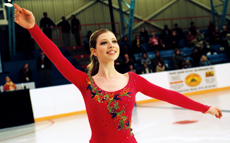If there is one thing that Disney accomplishes well, it is putting a shiny veneer of happiness over its dark attempts to subversively undermine the tenets of American society and Western, democratic ideals. Before I explain the previous sentence, allow me to give you the cold, hard facts of this movie.
This film is about a girl, Casey (Michelle Trachtenberg), who applies her rudimentary knowledge of high school physics to figure skating. While doing research for an academic scholarship, she plays Peeping Tom to spry, young figure skaters as they flit and twirl around the rink. Eventually, she falls in love with the sport and trains alongside them.
But there are two things in her way: her mother and her coach. Joan Cusack plays the overbearing mother part perfectly, insisting that her daughter not waste her time with frivolous sports, especially since it is an almost impossible dream. Sounds like good advice? Naturally, Casey rebels and trains anyway, while juggling school with practice, work and helping the other girls with their form, which she is now an expert on through the wonders of science.
While Cusack’s character is expected in a film like this, she plays the part with a post-feminist approach, harping against the skimpy uniforms and unlearned behavior of athletes. Casey’s rebellion is not only against the mother figure, but also against the empowerment of women through intelligence and perseverance rather than physical form and petite grace. The score thus far: Disney 1, society 0.
Next comes the coach, Tina Harwood (Kim Cattrall), who is not only a hard and demanding coach – just like Casey’s mother – but also an out and out cheater. Her philosophy is “win at all costs” and “take no prisoners,” resorting to mental and physical intimidation/injury in order for her student/daughter to win. Casey trains under her for a while, until her raw talent threatens the other figure skaters, leading Tina into dirty tricks.
But does this stop Casey from studying under her? Of course not. By the end of the movie, Tina’s right on her side again, although she promises that she is sober of cheating – of course. Score: Disney 2, society 0.
The most disturbing aspect of the film is the use and abuse of science. A young girl on the road to Harvard doesn’t sound like a bad idea, and the film’s initial insistence of applying science to skating is corny, but not threatening.
The real danger comes after the skating seduction begins. Skating for Casey becomes a drug, which she hides from her mom like a young speed freak would in any Lifetime movie. And instead of using her body to get her skating fix, she whores out science to other skaters in order to get her own fix.
By the end of the film, science takes a backseat to the more important social element of figure skating, and everyone is now happy again. Congratulations, Disney, you won this battle in a shutout, 3-0.
Jason Bolte can be reached at jmbolte@loyno.edu.






